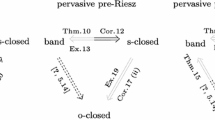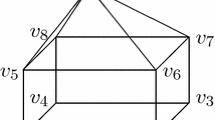Abstract
In vector lattices, the concept of a projection band is a basic tool. We deal with projection bands in the more general setting of an Archimedean pre-Riesz space X. We relate them to projection bands in a vector lattice cover Y of X. If X is pervasive, then a projection band in X extends to a projection band in Y, whereas the restriction of a projection band B in Y is not a projection band in X, in general. We give conditions under which the restriction of B is a projection band in X. We introduce atoms and discrete elements in X and show that every atom is discrete. The converse implication is true, provided X is pervasive. In this setting, we link atoms in X to atoms in Y. If X contains an atom \(a>0\), we show that the principal band generated by a is a projection band. Using atoms in a finite dimensional Archimedean pre-Riesz space X, we establish that X is pervasive if and only if it is a vector lattice.
Similar content being viewed by others
Notes
There are several alternative definitions of order convergence of nets in partially ordered vector spaces. However, by [6, Theorem 4.4] an operator T is order continuous if and only if T is continuous with respect to any of these alternative notions.
We stress that in [2, Definition 1.42] the authors introduce this concept using a different term. They call an element \(a\in X_+\) for which \(0\leqslant x\leqslant a\) implies that \(x=\lambda a\) for some real \(\lambda \geqslant 0\) an extremal vector or a discrete vector of \(X_+\). However, a similar concept is well-known in the less general setting of vector lattices. Indeed, [20, § 3] gives a definition of an atom in a vector lattice which differs from our notion by the fact that the considered element need not be positive. However, by [24, III.13.1 a)] for every atom \(a\in Y\) it follows \(a>0\) or \(a<0\). Moreover, if \(a<0\) is an atom, so is \(-a\). These circumstances maybe clarify that, based on [2, Definition 1.42], we define atoms as positive elements. Proposition 26 justifies our choice in Archimedean pervasive pre-Riesz spaces.
For instance, in [16, Definition 26.1] the terms atom and discrete element are used in a reversed way with respect to our terminology.
Minkowski’s theorem states that in a finite-dimensional normed vector space every element of a compact convex set \(S\subseteq X\) is a convex combination of extreme points of S, see e.g. [19, p. 1].
References
Aliprantis, C.D., Burkinshaw, O.: Positive Operators. Springer, New York (2006)
Aliprantis, C.D., Tourky, R.: Cones and Duality. Graduate Studies in Mathematics, vol. 84. American Mathematical Society, Providence, RI (2007)
Buskes, G., van Rooij, A.C.M.: The vector lattice cover of certain partially ordered groups. J. Austral. Math. Soc. (Series A) 54, 352–367 (1993)
Glueck, J.: A short note on band projections in partially ordered vector spaces. Indag. Math. 30(1), 1–6 (2019)
Glueck, J., Wolff, P.H.: Long-term analysis of positive operator semigroups via asymptotic domination. Positivity 23(5), 1113–1146 (2019)
Hauser, T., Kalauch, A.: Order continuity from a topological perspective. https://arxiv.org/abs/1711.02929, (2017, Submitted)
Kalauch, A., Lemmens, B., van Gaans, O.: Riesz completions, functional representations, and anti-lattices. Positivity 18(1), 201–218 (2014)
Kalauch, A., Lemmens, B., van Gaans, O.: Bands in partially ordered vector spaces with order unit. Positivity 19(3), 489–511 (2015)
Kalauch, A., Malinowski, H.: Order continuous operators on pre-Riesz spaces and embeddings. Z. Anal. Anwend. 38(4), 375–395 (2019)
Kalauch, A., Malinowski, H.: Pervasive and weakly pervasive pre-Riesz spaces. Indag. Math. (N.S.) 30(2), 375–385 (2019)
Kalauch, A., Malinowski, H.: Vector lattice covers of ideals and bands in pre-Riesz spaces. Quaest. Math. 47(7), 919–937 (2019)
Kalauch, A., van Gaans, O.: Disjointness in partially ordered vector spaces. Positivity 10(3), 573–589 (2006)
Kalauch, A., van Gaans, O.: Bands in pervasive pre-Riesz spaces. Oper. Matrices 2(2), 177–191 (2008)
Kalauch, A., van Gaans, O.: Ideals and bands in pre-Riesz spaces. Positivity 12(4), 591–611 (2008)
Kalauch, A., van Gaans, O.: Pre-Riesz Spaces. De Gruyter, Berlin (2018)
Luxemburg, W.A.J., Zaanen, A.C.: Riesz Spaces I. North-Holland, Amsterdam (1971)
Malinowski, H.: Order closed ideals in pre-Riesz spaces and their relationship to bands. Positivity 22(4), 1039–1063 (2018). arxiv:1801.09963
Meyer-Nieberg, P.: Banach Lattices. Springer, Berlin (1991)
Phelps, R.R.: Lectures on Choquet’s Theorem. Springer, Berlin (2000)
Schaefer, H.H.: Banach Lattices and Positive Operators. Springer, Berlin (1974)
van Gaans, O.: Seminorms on ordered vector spaces. Proefschrift (Ph.D. thesis), Universiteit Nijmegen, Nederland (1999)
van Haandel, M.: Completions in Riesz Space Theory. Proefschrift (Ph.D. thesis), Katholieke Universiteit Nijmegen, Nederland (1993)
van Waaij, J.: Tensor products in Riesz space theory. Master’s thesis, Mathematisch Instituut, Universiteit Leiden, Nederland (2013)
Vulikh, B.Z.: Introduction to the Theory of Partially Ordered Spaces. Wolters-Noordhoff Ltd, Groningen (1967)
Vulikh, B.Z.: Geometrie der Kegel in normierten Räumen. De Gruyter, Berlin (2017). (Translated from Russian and edited by M.R. Weber)
Author information
Authors and Affiliations
Corresponding author
Additional information
Publisher's Note
Springer Nature remains neutral with regard to jurisdictional claims in published maps and institutional affiliations.
Rights and permissions
About this article
Cite this article
Kalauch, A., Malinowski, H. Projection bands and atoms in pervasive pre-Riesz spaces. Positivity 25, 177–203 (2021). https://doi.org/10.1007/s11117-020-00757-7
Received:
Accepted:
Published:
Issue Date:
DOI: https://doi.org/10.1007/s11117-020-00757-7
Keywords
- Order projection
- Projection band
- Band projection
- Principal band
- Atom
- Discrete element
- Extremal vector
- Pervasive
- Weakly pervasive
- Archimedean directed ordered vector space
- Pre-Riesz space
- Vector lattice cover




